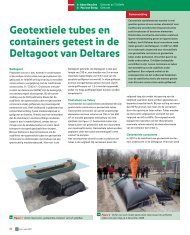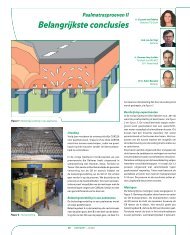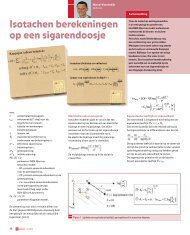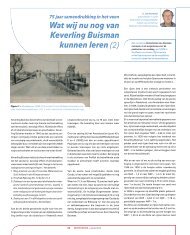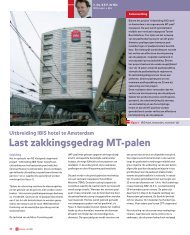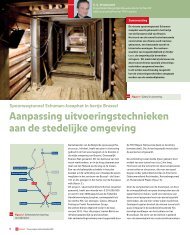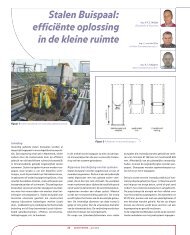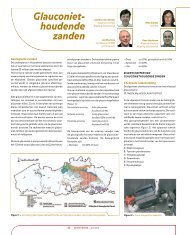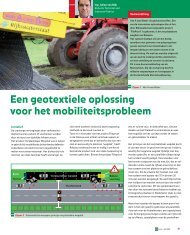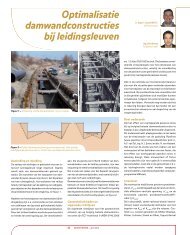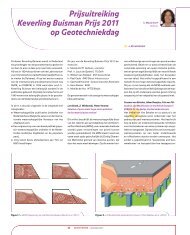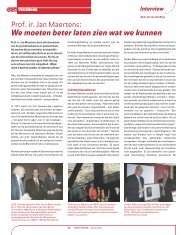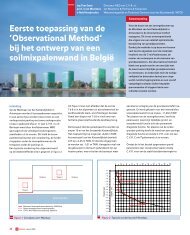i137 GEO binnen - GeoTechniek
i137 GEO binnen - GeoTechniek
i137 GEO binnen - GeoTechniek
You also want an ePaper? Increase the reach of your titles
YUMPU automatically turns print PDFs into web optimized ePapers that Google loves.
Rigidity of the station<br />
The tilt meters have been installed in the station to<br />
calculate the vertical deformation of the south side<br />
of the station under the assumption that the station<br />
sections behave rigid. During the building activities<br />
this hypothesis was questioned, because of small<br />
leakages of the station and unexplainable differences<br />
between results of the automatic monitoring<br />
system and the measurements of RPW. To investigate<br />
the rigidity of the station additional points were placed<br />
in the centre of the station. With these points<br />
cross profiles of the station could be constructed.<br />
However, after installation of these points no<br />
significant displacements of the station were<br />
measured anymore. As a result no conclusion could<br />
be drawn about the hypothesis of the rigidity of the<br />
station sections (Huisman and Berkelaar, 2006).<br />
CONCLUSIONS AND<br />
RECOMMENDATIONS<br />
CONCLUSIONS<br />
The most prominent risk, interference of operation of<br />
the metro station, did not occur. Full accessibility of<br />
all services was maintained during all building<br />
activities.<br />
The monitoring system operated according to<br />
contract specifications. The on-line presentation and<br />
checking on hazard warning levels was very helpful in<br />
detecting the effect of building activities on the<br />
metro station. The examples in this paper show how<br />
monitoring has been used to control building risks.<br />
RECOMMENDATIONS<br />
As a result of the problems with refraction due to the<br />
semi-confined structure of the station and the<br />
questioned rigidity of the station, a system with<br />
more internal control was recommended for phase<br />
2 of the project and for semi-confined spaces in<br />
general. With 2 tachymeters points are measured<br />
from different positions. Refraction problems will be<br />
eliminated and/or detected in time because it is<br />
unlikely that refraction and temperature peaks would<br />
have the same effect on measurements from two<br />
directions. The monitoring specifications for phase 2<br />
were set up in such a way that the recommendations<br />
from phase 1 were taken into account. Two tachymeters<br />
were specified in combination with crack<br />
meters placed over the station section joints. <br />
ACKNOWLEDGEMENTS<br />
The authors acknowledge the graphical contributions<br />
from Ton de Keiser of Rotterdam Public Works –<br />
Engineering Department.<br />
DEFORMATION MONITORING OF THE UNDERGROUND METRO STATION ROTTERDAM CS<br />
FIGURE 9<br />
REFERENCES<br />
– Berkelaar, R. (2006) Coping with underground risks<br />
during the development of a new underground metro<br />
station in Rotterdam, Proceedings of the 10th IAEG<br />
International Congres, Nottingham, United<br />
Kingdom.<br />
– Huisman, L. (2005) Deformatiemetingen staartspoor<br />
Metro CS week 25 (Results of verification measurements<br />
metro station week 25), Internal memo RPW,<br />
Rotterdam, the Netherlands.<br />
– Huisman, L., and Berkelaar, R. (2006), Evaluatie<br />
monitoring Metro CS Fase I (Evaluation monitoring<br />
metro station CS Phase 1), Internal report RPW,<br />
R.2006.012.RR, Rotterdam, the Netherlands.<br />
– Luijten, C.J.L.M. (2002) Betuweroute en grondverzet,<br />
Handboek Bouwstoffenbesluit (Betuweroute<br />
and earth moving, Manual of building materials<br />
regulations), part 9-16 page 1-20, Weka Uitgeverij,<br />
Amsterdam, the Netherlands.<br />
– Man, C.H. (2005) Een systematiek voor risicomanagement<br />
tijdens de uitvoeringsfase in een complex<br />
stedelijk civieltechnisch project (Systematic approach<br />
for risk management in complex urban construction<br />
projects), M.Sc. thesis C.H. Man, University of<br />
Twente, Enschede, the Netherlands.<br />
RELATION BETWEEN STATION TEMPERATURE AND VERTICAL DEFORMATION.<br />
– Visser, A. (2005) Meetopzet deformatiemetingen<br />
Metro CS (Design of deformation measurements<br />
metro CS), Internal memo RPW, Rotterdam,<br />
the Netherlands.<br />
Reprinted with permission from ASCE.<br />
1 Robert Berkelaar is Geotechnical Engineer, MSc<br />
Engineering Geology, Rotterdam Public Works –<br />
Engineering Department, PO Box 6633,<br />
3002 AP Rotterdam, the Netherlands<br />
r.berkelaar@gw.rotterdam.nl<br />
2 Lennard Huisman is Geodetic Engineer, MSc<br />
Geodetic Engineering, Iv-Infra b.v., PO Box 1155,<br />
3350 CD Papendrecht, the Netherlands,<br />
currently working for University of Technology Delft,<br />
Faculty of Aerospace Engineering,<br />
l.huisman@tudelft.nl<br />
3 Cor J.L.M. Luijten is Monitoring Supervisor, MA<br />
Geography, Rotterdam Public Works – Engineering<br />
Department, PO Box 6633, 3002 AP Rotterdam,<br />
the Netherlands, cjlm.luijten@gw.rotterdam.nl<br />
4 Rotterdamse Electrische Tram i.e.<br />
Rotterdam public transport company.<br />
5 Rotterdam Public Works.<br />
<strong>GEO</strong>international – October 2008 43




